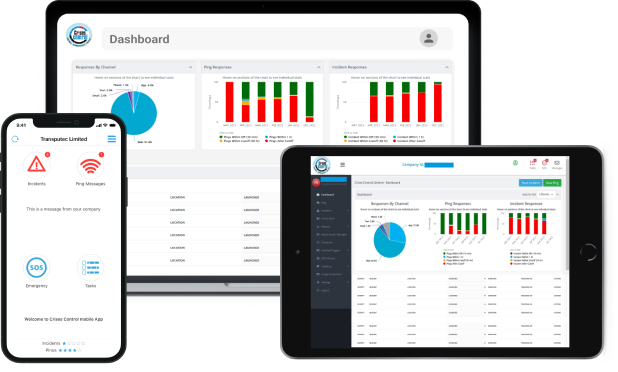Written by Anneri Fourie | Crises Control Executive
Imagine this: A major IT outage disrupts your company’s operations, employees are left scrambling for answers, and critical decisions are delayed because your Business Continuity Plans (BCP) are locked away in a binder or buried in a PDF no one can access. This scenario is more common than you might think, and for many organisations, outdated continuity planning leads to unnecessary downtime, confusion, and financial losses.
A well-structured BCP is essential for keeping operations running during disruptions, but relying on traditional, paper-based plans slows down response times and increases risk. In an emergency, quick action and clear communication are vital, every minute counts. That’s why businesses are moving towards digital Business Continuity Plans that improve accessibility, automate critical processes, and provide real-time coordination.
This blog explores the limitations of traditional BCPs, the benefits of digitalising your continuity plan, and how Crises Control’s Business Continuity Platform can help your organisation respond faster and reduce risk.
The Limitations of Traditional Business Continuity Plans
Many organisations spend time creating detailed BCPs, only for them to sit in a folder, rarely updated or tested. While traditional plans provide a basic framework for continuity, they often fail in real-world scenarios. Here’s why:
1. Limited Accessibility Leads to Delays
During an emergency, teams need immediate access to the BCP. If the plan is stored in a filing cabinet or as a static document in an internal server, employees may struggle to locate the latest version when time is of the essence. This slows down decision-making and increases downtime.
2. Updates Are Time-Consuming and Error-Prone
Business environments change constantly, whether it’s staff turnover, new regulations, or evolving risks. Updating a paper-based or PDF-based BCP is a manual, time-consuming process that often leads to outdated information being used in critical situations.
3. Lack of Real-Time Communication
A business continuity plan is only useful if employees and stakeholders know what to do. Traditional plans don’t provide real-time alerts or guidance, making it difficult to coordinate responses, allocate resources effectively, and track progress during an incident.
4. Compliance and Audit Challenges
Regulators and insurers require businesses to demonstrate robust continuity planning. With a paper-based system, tracking plan revisions, documenting response actions, and proving compliance can become an administrative headache.
If a BCP is difficult to access, maintain, and communicate, it’s not an effective tool for crisis management. This is where digital Business Continuity Plans come in.
The Benefits of Digital Business Continuity Plans
Moving to a digital Business Continuity Platform transforms crisis management by improving speed, efficiency, and coordination. Here’s how:
1. Immediate Access to Critical Information
A digital BCP is securely stored in the cloud, ensuring employees can access up-to-date plans anytime, anywhere. Whether staff are working remotely, on the front lines, or in different time zones, they can retrieve critical response procedures instantly.
2. Automated Response to Minimise Downtime
Rather than relying on manual steps, a digital continuity plan enables automated incident workflows that trigger immediate actions when a disruption occurs. This includes:
- Mass notifications to alert key personnel within seconds.
- Pre-assigned tasks that ensure everyone knows their role.
- Incident tracking to monitor progress and ensure accountability.
By removing manual delays, organisations can respond faster and more effectively.
3. Real-Time Communication for Seamless Coordination
During a crisis, clear and timely communication is crucial. A Business Continuity Platform with Mass Notification Software ensures that employees receive real-time alerts via multiple channels, including:
- SMS
- Push notifications
- Voice calls
This ensures that no one is left uninformed, reducing confusion and enabling a coordinated response.
4. Built-In Compliance and Audit Readiness
Digital platforms provide automated reporting and audit logs, making it easier to track:
- Incident responses
- Plan updates
- Regulatory compliance
This reduces the risk of penalties and ensures that businesses meet industry standards.
5. Continuous Improvement Through Testing and Analytics
A strong business continuity plan isn’t static, it evolves. Digital platforms allow organisations to run simulations and tabletop exercises to test their response strategies. Analytics provide insights into how incidents are handled, helping businesses refine their plans and improve future responses.
How Crises Control Enhances Business Continuity Planning
Crises Control provides a comprehensive Business Continuity Platform designed to help organisations digitalise and automate their crisis management processes. Here’s how it strengthens business resilience:
1. Cloud-Based Business Continuity Plans
With Crises Control, your BCP is securely stored in the cloud, providing instant access from any device. This eliminates the need for physical documents and ensures that employees are always working with the latest version of the plan.
2. Automated Incident Response to Reduce Downtime
When an incident occurs, Crises Control’s Incident Manager:
- Automatically triggers predefined response plans.
- Assigns and monitors tasks in real time.
- Notifies key stakeholders instantly, keeping everyone informed.
This level of automation ensures that response times are minimised and disruptions are handled efficiently.
3. Integrated Mass Notification Software for Instant Alerts
Communication is key during a crisis. Crises Control’s Mass Notification Software enables businesses to send emergency alerts to employees, partners, and customers via multiple communication channels. This ensures that critical information is delivered quickly and effectively.
4. Task Manager for Efficient Execution
A well-structured response requires clear roles and responsibilities. Crises Control’s Task Manager:
- Assigns critical tasks to specific team members.
- Tracks progress in real time.
- Ensures that every step of the plan is executed correctly.
This prevents miscommunication and delays.
5. Detailed Reporting for Compliance and Audits
Regulatory compliance requires businesses to keep detailed records of incidents and responses. Crises Control automatically logs every action taken during an incident, creating a full audit trail that simplifies compliance and post-event analysis.
6. Mobile App for On-the-Go Crisis Management
Emergencies don’t always happen when you’re at your desk. Crises Control’s mobile app allows teams to:
- Access the BCP from their smartphones.
- Send alerts to employees with a single tap.
- Manage incidents from anywhere.
This ensures that business leaders and employees can respond immediately, even if they are offsite.
Conclusion: Strengthen Your Business Continuity Plan with Crises Control
Relying on outdated Business Continuity Plans exposes your organisation to unnecessary risks. By embracing digital transformation, businesses can:
- Improve response times with automated workflows.
- Ensure seamless communication with Mass Notification Software.
- Maintain regulatory compliance with audit-ready documentation.
- Continuously improve their continuity strategies with real-time data and analytics.
Crises Control provides the tools you need to digitalise and streamline your Business Continuity Plan. Don’t wait for a crisis to expose the gaps in your planning—take action now.
Get a free personalised demo today and see how Crises Control can help protect your business.
Request a FREE Demo








